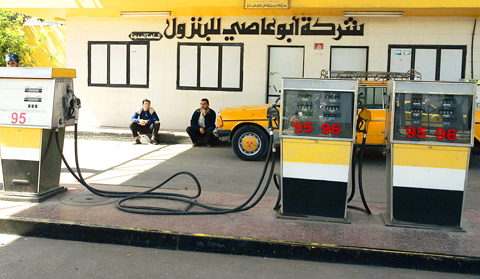Muin Abdul Ghani sleeps in his car, parked among dozens of other vehicles at a gas station, unwilling to give up his place in line in his desperate scramble for gasoline.
It’s one way Gaza’s embattled 1.4 million residents are adjusting their lives around their newest crisis -- a protest of gas station owners following months of restricted Israeli fuel supplies.
Gaza residents also wrestle with high black market prices and overstuffed taxis. They have turned to bicycles, liquid gas for their cars and homemade fuel recipes to try to deal with the shortage.

PHOTO: AP
Israel has restricted fuel supplies since September to pressure Palestinian militants into halting rocket fire at neighboring Israeli communities, but with no apparent results.
“We are like street dogs looking for bones,” said Abdul Ghani, a 44-year-old taxi driver, smoking by his car at a gas station in the northern Gaza Strip town of Jebaliya.
Around 200 cars, taxis, delivery trucks and farm machinery vehicles were parked there, waiting for the gas station to distribute rationed supplies. Some drivers abandoned their cars, while others sold their places in line.
Abdul Ghani slept in his car overnight and expected to wait at least another day for a day’s worth of fuel. Gaza’s Hamas government rations out fuel by only allowing Gaza residents to take 17 liters at a time.
Israel supplies around 70,000 liters of gasoline a week, 8 percent of Gaza’s needs and 800,000 liters of diesel fuel -- 30 percent of Gaza’s needs, Palestinians charge.
Israeli army Colonel Nir Press, commander of the military liaison unit, countered that Israel is supplying Gaza with more than enough fuel for its basic needs, but the Islamic Hamas movement is using some of it for its own purposes, including fuel for vehicles that ferry rockets to be fired at Israel.
“I really don’t think that this is a crisis,” Press said. “ They want to create an appearance of a crisis.”
The Hamas government takes around half of Gaza’s reduced supplies for hospitals, municipal services, water wells and sewage pumps, said Ziad Zaza, a senior Hamas government official.
Protesting the shortages, gas station owners rebelled on Monday, refusing to sell the small amounts they have in stock or to accept future shipments.
Gaza residents are seeking their own solutions. Drivers pay black market prices for siphoned-off fuel. One taxi driver purchased a 17-liter tank for US$33 from a sneaky gas station employee. Gas sells at the pump for US$27 for a 17-liter tank.
“It was a good deal. We just want to keep our business running,” said the driver, who asked not to be named because the Hamas government forbids black market fuel trading.
Other black market traders offer 17-liter tanks for US$55.
Reflecting the shortages, shared taxis that once fit seven people are now piling in 10, sometimes 15 people.
At a Gaza City road where shared cabs ship university students home, men and women stood in unhappy clumps waiting for rides.
Heba Mina, a 22-year-old student was waiting for a ride to her central Gaza Strip home. It used to take seconds to get a cab. Now the wait is longer.
Mina, who wears a full face veil and long black robe, now squeezes into cabs filled with men, once forbidden by conservative Gaza Muslim etiquette, often the 10th passenger in a vehicle built to take seven.
“It’s embarrassing, but I’m desperate,” Mina said.
She missed two classes because she couldn’t find transport.
Other Gaza residents are mixing kerosene with used cooking oil to power their cars, but it’s not clear whether it actually works.
Fawzi Hisi, 25, a Hamas police officer, dusted off his childhood bike two months ago.
“I couldn’t find a taxi to get to work,” Hisi said.
He’s lucky. His colleagues can’t afford new bicycles, and can’t find second-hand bikes, now in short supply.
Hisi said the fuel shortage wouldn’t shake his loyalty to the Hamas government.
“I’ll walk if I have to. We won’t die from a fuel shortage,” he said.

POLITICAL PRISONERS VS DEPORTEES: Venezuela’s prosecutor’s office slammed the call by El Salvador’s leader, accusing him of crimes against humanity Salvadoran President Nayib Bukele on Sunday proposed carrying out a prisoner swap with Venezuela, suggesting he would exchange Venezuelan deportees from the US his government has kept imprisoned for what he called “political prisoners” in Venezuela. In a post on X, directed at Venezuelan President Nicolas Maduro, Bukele listed off a number of family members of high-level opposition figures in Venezuela, journalists and activists detained during the South American government’s electoral crackdown last year. “The only reason they are imprisoned is for having opposed you and your electoral fraud,” he wrote to Maduro. “However, I want to propose a humanitarian agreement that

ECONOMIC WORRIES: The ruling PAP faces voters amid concerns that the city-state faces the possibility of a recession and job losses amid Washington’s tariffs Singapore yesterday finalized contestants for its general election on Saturday next week, with the ruling People’s Action Party (PAP) fielding 32 new candidates in the biggest refresh of the party that has ruled the city-state since independence in 1965. The move follows a pledge by Singaporean Prime Minister Lawrence Wong (黃循財), who took office last year and assumed the PAP leadership, to “bring in new blood, new ideas and new energy” to steer the country of 6 million people. His latest shake-up beats that of predecessors Lee Hsien Loong (李顯龍) and Goh Chok Tong (吳作棟), who replaced 24 and 11 politicians respectively

Young women standing idly around a park in Tokyo’s west suggest that a giant statue of Godzilla is not the only attraction for a record number of foreign tourists. Their faces lit by the cold glow of their phones, the women lining Okubo Park are evidence that sex tourism has developed as a dark flipside to the bustling Kabukicho nightlife district. Increasing numbers of foreign men are flocking to the area after seeing videos on social media. One of the women said that the area near Kabukicho, where Godzilla rumbles and belches smoke atop a cinema, has become a “real

‘WATER WARFARE’: A Pakistani official called India’s suspension of a 65-year-old treaty on the sharing of waters from the Indus River ‘a cowardly, illegal move’ Pakistan yesterday canceled visas for Indian nationals, closed its airspace for all Indian-owned or operated airlines, and suspended all trade with India, including to and from any third country. The retaliatory measures follow India’s decision to suspend visas for Pakistani nationals in the aftermath of a deadly attack by shooters in Kashmir that killed 26 people, mostly tourists. The rare attack on civilians shocked and outraged India and prompted calls for action against their country’s archenemy, Pakistan. New Delhi did not publicly produce evidence connecting the attack to its neighbor, but said it had “cross-border” links to Pakistan. Pakistan denied any connection to